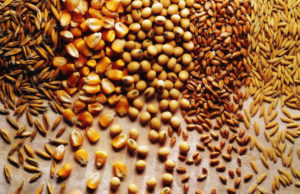 Grain futures were mixed on Monday with corn and soybeans marking new record lows, while wheat advanced for a sixth day out of seven.
Grain futures were mixed on Monday with corn and soybeans marking new record lows, while wheat advanced for a sixth day out of seven.
On the Chicago Board of Trade, corn futures for September delivery traded at $4.7338 a bushel at 9:21 GMT, down 0.47% on the day. The grain hit a new 35-month low at $4.7138 during the early Asian session, while days high stood at $4.7488 a bushel. The grain tumbled 2.38% on Friday and settled the week 3.18% lower after falling 9.6% the preceding two.
Corn has fallen 34% so far this year, underperforming the Standard & Poor’s GSCI Index of eight agricultural commodities, which tumbled 19% so far. The USDA trimmed its latest U.S. corn crop output forecast to 13.95 billion bushels, down from 14.005 billion, but that is however still an all-time record high and is 29% higher than last year’s drought damaged crop. This year’s global stockpiles are projected to rise to 150.97 million tons by the end of the 2013-2014 marketing year, 22% more than the previous period..
According to researcher Doane Advisory Services Co. in St. Louis, U.S. corn output in 2013 will exceed USDAs forecast and surge to 14.269 billion bushels.
The International Grains Council said last week that favorable weather and advancing harvests reinforced prospects for a significant rebound in northern hemisphere grain output after last year’s drought damaged crops. Global corn output is expected to surge by 9.7% to 942 million tons in the 2013-2014 season. The grain fell 6.3% in July, marking a sixth consecutive monthly decline, the worst run since 1996. The grain has fallen over 32% so far this year, underperforming the Standard & Poor’s GSCI Index of eight agricultural commodities, which lost 17%.
Simon Clancy, director for brokering services at Ikon Commodities Pty Ltd. in Sydney, said for Bloomberg: “Things are less threatening and the crop looks to be a known quantity now. Global consumers are seeing that and probably relaxing a little, becoming more comfortable that they’ll be able to get supply at current levels or lower.”
DTN said in a report last week that cool weather across the U.S. within the next 10 days will support corn pollination, while rains in the Midwest will aid pod-filling soybeans.
Soybeans hit the lowest since January 2012
Soybeans, the second biggest U.S. crop after corn, also extended their steep fall, supported by favorable weather conditions in the United States. Soybeans for September delivery traded at $12.0888 a bushel at 9:22 GMT, down 0.27% on the day. The oilseed hit a days low of $12.0550 in early Asian trading, the lowest level since January 2012. The contract tumbled 1.89% on Friday, a ninth consecutive daily decline, and closed the week 10.23% lower after plunging 9.39% the previous one.
Soybeans fell 3.7% in July, marking a second monthly decline in a row. The oilseed has declined 16% so far this year as the USDA projected domestic output will jump by 13% to a record 3.42 billion bushels, which would boost global inventories by 20% to an all-time record high of 74.1 million tons. Goldman Sachs’s 12-month price estimate for soybeans remained at $11 per bushel.
Meanwhile, wheat for September delivery rose to $6.6150 a bushel at 9:12 GMT, marking a 0.17% daily advance. Prices ranged between days high and low of $6.6538 and $6.5938 a bushel respectively. The grain gained 0.17% on Friday, a fifth daily gain in six, and settled the week 1.69% higher amid increased physical demand as countries began refilling stockpiles.
Japan bought 89 579 tons of western-white wheat from the U.S. on Thursday, the first purchase after lifting a two-month suspension on Oregon white wheat as an unauthorized genetically modified strain was detected growing in Oregon. The resumption of U.S. wheat imports eased concern over short supply in Japan, which imports 90% of the wheat it needs and 60% of total food. Japan already purchased earlier in July 23 963 tons of club wheat grown in Washington state, 1,497 tons of Australian premium-white and 1,710 tons of U.S. soft-red winter.
Meanwhile on Wednesday, Egypt, the world’s largest wheat importer, made a fourth purchase this month, ordering 240 000 tons from suppliers in Romania and Ukraine.





